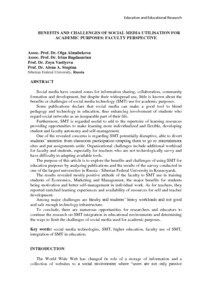Benefits and challenges of social media utilization for academic purposes: faculty perspective
Автор:
Olga, Almabekova
Irina, Bagdasarian
Zoya, Vasilyeva
Alena A. Stupina
Коллективный автор:
Институт управления бизнес-процессами и экономики
Кафедра экономики и управления бизнес-процессами
Кафедра маркетинга
Дата:
2015-08Журнал:
Conference proceedings SGEM 2015Квартиль журнала в Web of Science:
без квартиляБиблиографическое описание:
Olga, Almabekova. Benefits and challenges of social media utilization for academic purposes: faculty perspective [Текст] / Almabekova Olga, Bagdasarian Irina, Vasilyeva Zoya, Alena A. Stupina // Conference proceedings SGEM 2015. — 2015. — book 1 (VOLUME: 2). — С. 97-103Аннотация:
Social media have created zones for information sharing, collaboration, community formation and development, but despite their widespread use, little is known about the benefits or challenges of social media technology (SMT) use for academic purposes.
Some publications declare that social media can make a good tool to blend pedagogy and technology in education, thus enhancing involvement of students who regard social networks as an inseparable part of their life.
Furthermore, SMT is regarded useful to add to the repertoire of learning resources providing opportunities to make learning more individualized and flexible, developing student and faculty autonomy and self-management.
One of the revealed concerns is regarding SMT potentially disruptive, able to divert students’ attention from classroom participation tempting them to go to entertainment sites and put assignments aside. Organizational challenges include additional workload for faculty and students, especially for teachers who are not technologically savvy and have difficulty in adapting available tools.
The purpose of this article is to explore the benefits and challenges of using SMT for education purposes by analyzing publications and the results of the survey conducted in one of the largest universities in Russia - Siberian Federal University in Krasnoyarsk.
The results revealed mostly positive attitude of the faculty to SMT use in training students of Economics, Marketing and Management, the major benefits for students being motivation and better self-management in individual work. As for teachers, they reported enriched learning experiences and availability of resources for self and teacher development.
Among major challenges are faculty and students’ heavy workloads and not good and safe enough technology infrastructure.
To conclude, there are numerous opportunities for researchers and educators to continue the research on SMT integration in educational environments and determining the ways to limit the challenges of social media used for academic purposes.

